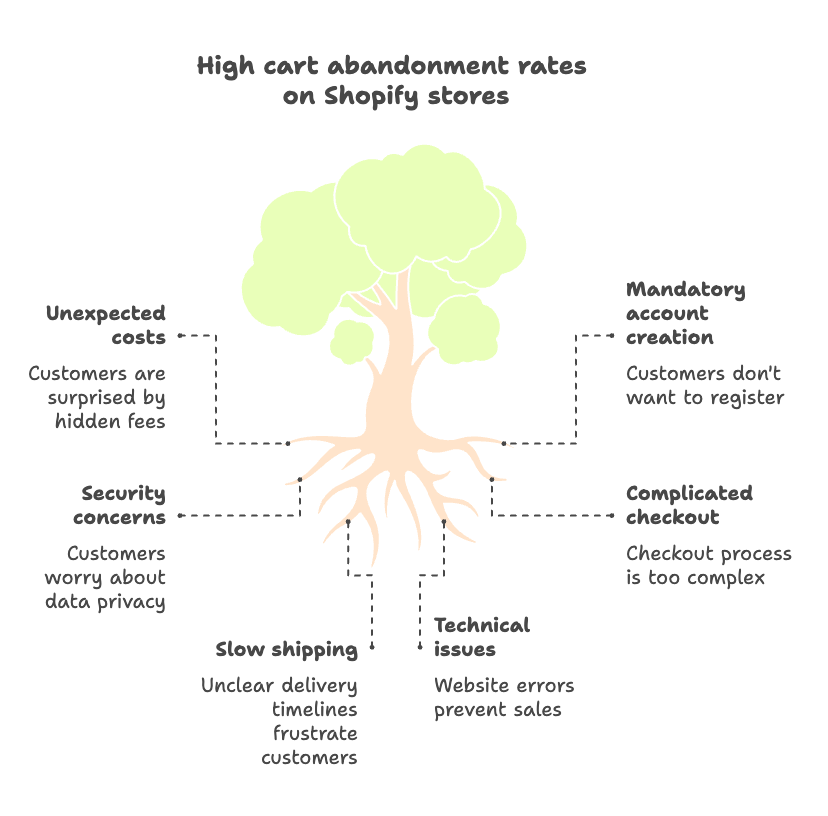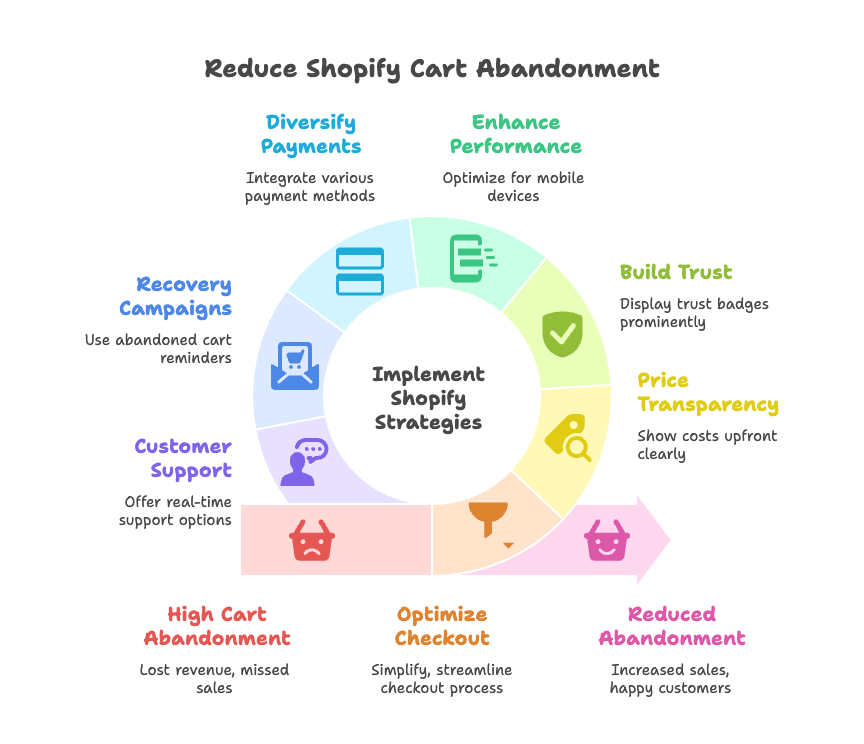Picture this: a potential customer spends twenty minutes browsing your Shopify store, carefully selecting products, adding them to their cart, and then… disappears. Gone. No purchase, no explanation, just an abandoned cart sitting in your analytics like a ghost of lost revenue.
You’re not alone in this frustration. Cart abandonment plagues virtually every Shopify store, with average rates hovering around 70%. That means seven out of ten customers who show genuine purchase intent walk away without buying. The impact? Massive. We’re talking about lost sales that directly hit your profit margins, tank your marketing ROI, and stall your store’s growth potential.
But here’s the thing – cart abandonment isn’t just a problem to endure. It’s a puzzle to solve. By understanding exactly why customers abandon their carts, you can implement targeted solutions that not only recover lost sales but transform your entire customer experience. Ready to turn those abandoned carts into completed purchases? Let’s dive into the real reasons customers walk away and the proven strategies that bring them back.
What Is Cart Abandonment on Shopify?
Definition and Scope
Cart abandonment happens when customers add items to their shopping cart but leave without completing the purchase. Simple concept, massive impact. This behavior affects all Shopify stores – whether you’re a starter just launching your first product or an advanced operator managing multiple revenue streams.
The abandonment process isn’t limited to just the cart page. Customers can drop off at multiple stages: during cart review, at checkout, while creating an account, or even when signing up for reward programs. Each exit point represents a unique friction moment that demands your attention.
Shopify’s built-in “Abandoned Checkouts” analytics provide valuable insight into when and where customers drop off. These metrics aren’t just numbers – they’re breadcrumbs leading you to the exact moments your store loses potential buyers. Tracking these patterns helps identify trends, pinpoint bottlenecks, and reveal actionable improvement opportunities that can transform your conversion rates.
Most Common Reasons for Cart Abandonment on Shopify Stores

Unexpected Costs & Lack of Price Transparency
Nothing kills a purchase faster than surprise charges. When customers reach checkout and discover unexpected shipping fees, taxes, or handling charges, 48% of them abandon their carts immediately. It’s like being excited about a restaurant meal only to discover hidden service charges on the bill.
The solution? Radical transparency from the start. Show all costs upfront using shipping calculators, highlight your free shipping thresholds prominently, and consider absorbing smaller fees into your product prices. When customers know exactly what they’ll pay before they commit, trust increases and abandonment plummets.
Mandatory Account Creation
Forcing customers to create an account before purchasing is like asking for their life story before a first date. Over 25% of users abandon their carts when required to register. They want to buy now, not fill out forms and remember another password.
Enable guest checkout instead. Let customers complete their purchase quickly, then encourage account creation afterward by highlighting benefits like order tracking, faster future checkouts, and exclusive member perks. Post-purchase is the perfect time to build that relationship – after they’ve already experienced your value.
Security & Trust Concerns
In an era of data breaches and online fraud, 25% of shoppers cite credit card security and data privacy concerns as reasons for abandonment. If your checkout doesn’t feel secure, customers won’t risk their information.
Build trust aggressively. Display security badges prominently, ensure your SSL certificate is visible, showcase customer reviews and testimonials, and maintain a crystal-clear return policy. Trust isn’t assumed online – it’s earned through visible security measures and social proof.
Complicated & Lengthy Checkout Process
A complicated checkout is like a maze with no clear exit. When 22% of customers abandon due to complex checkout processes, your forms are working against you. Every extra click, every unnecessary field, every confusing step increases the chance they’ll give up.
Streamline ruthlessly. Minimize required fields to absolute essentials, use Shopify’s optimized checkout features, and ensure your mobile experience is flawless. The best checkout is the one customers barely notice – smooth, fast, and intuitive.
Slow Shipping or Unclear Delivery Timelines
When 23% of customers cite slow delivery as an abandonment reason, speed expectations are clear. But it’s not just about fast shipping – it’s about clear communication. Vague delivery estimates like “5-7 business days” create uncertainty and doubt.
Offer multiple shipping options with precise delivery dates. Use apps that calculate real-time delivery estimates based on the customer’s location. When people know exactly when their order will arrive, they’re far more likely to complete the purchase.
Technical Issues and Website Performance
Technical problems account for 17% of cart abandonments. Slow load times, error messages, or mobile-unfriendly designs don’t just frustrate customers – they actively prevent sales. Your website performance is your sales performance.
Conduct regular site audits, optimize for speed, and ensure responsive design across all devices. Every second your site takes to load costs you customers. Every broken link or error message is lost revenue.
Limited Payment Options
When 13% of customers can’t use their preferred payment method, you’re literally turning away money. Not everyone uses credit cards. Some prefer digital wallets, others want buy-now-pay-later options, and many international customers need region-specific solutions.
Diversify your payment options. Add digital wallets like Apple Pay and Google Pay, integrate buy-now-pay-later services, enable Shopify’s Shop Pay, and consider PayPal for broader accessibility. The more ways customers can pay, the more will actually complete their purchase.
Understanding Behavior: Window Shopping and Hesitation
Comparison & Window Shopping
Not every cart abandonment signals a problem with your store. Some shoppers add items to their cart for research or price comparison – digital window shopping, if you will. This behavior is natural and often unavoidable.
The key is distinguishing between research-phase browsers and genuinely interested buyers who hit friction points. Use retargeting campaigns, personalized offers, and gentle reminders to recapture the attention of researchers when they’re ready to buy.
Hesitation & Unanswered Questions
Sometimes customers abandon carts because they can’t find the information they need to feel confident about their purchase. Missing product details, unclear sizing guides, or absent customer service create doubt that kills conversions.
Combat hesitation with comprehensive product pages, live chat support, detailed FAQ sections, and easy access to customer reviews. When questions arise, answers should be immediately available. Hesitation is often just a request for more information in disguise.
Actionable Shopify Strategies to Reduce Cart Abandonment

Optimize Checkout Experience
Your checkout experience should feel effortless. Implement a simplified, single-page checkout that minimizes form fields and enables guest purchases. Leverage Shopify’s built-in settings to streamline the process without sacrificing necessary information.
Express checkout options like Shop Pay, PayPal, and Google Pay can reduce checkout time to seconds. When customers can complete purchases with a single click or touch, abandonment rates drop dramatically. Speed isn’t just convenient – it’s profitable.
Provide Price Transparency & Incentives
Clear, upfront pricing eliminates the shock of unexpected costs. Use shipping calculators that show costs before checkout, highlight free shipping thresholds prominently, and consider using popups or cart indicators that display running totals.
Strategic incentives can tip hesitant buyers toward purchase. Conditional discounts, time-limited offers, and personalized deals based on browsing behavior can provide the gentle nudge needed to complete transactions without devaluing your brand.
Build Trust & Demonstrate Security
Trust badges and SSL certificates should be prominently displayed throughout your checkout process. But don’t stop there – integrate customer testimonials, showcase user-generated content, and make product reviews easily accessible.
Social proof is incredibly powerful. When potential customers see that others have purchased successfully and happily, their confidence in your store increases exponentially. Use Shopify review apps to collect and display authentic customer feedback prominently.
Enhance Performance & Mobile Experience
Your mobile experience can make or break sales, especially since mobile commerce continues growing rapidly. Ensure your Shopify theme is optimized for mobile devices, loads quickly, and provides bug-free navigation across all screen sizes.
Regular site monitoring and performance diagnostics help identify issues before they impact sales. Use tools to track load times, identify broken links, and ensure your checkout process works flawlessly on every device and browser.
Diversify Payment Methods
Payment flexibility equals more completed purchases. Integrate digital wallets, buy-now-pay-later options, traditional credit and debit cards, and even cryptocurrency where appropriate. Use Shopify’s gateway integrations to support regional payment preferences.
Different customer segments prefer different payment methods. Young customers might prefer buy-now-pay-later, while international customers might need region-specific options. The broader your payment acceptance, the wider your potential customer base.
Use Recovery Campaigns & Retargeting
Abandoned cart emails and SMS campaigns can recover significant revenue from customers who initially walked away. Use automated reminders through Shopify and partner apps like Klaviyo or Omnisend to re-engage these warm prospects.
Push notifications and retargeting ads that show dynamic content featuring the specific products customers viewed create powerful reminders across social media and the web. These campaigns keep your products top-of-mind when customers are ready to buy.
Customer Support and Engagement
Live chat and instant support through tools like Shopify Inbox allow you to address objections in real-time, recommend complementary products, and offer personalized discounts directly within the conversation. Real-time support can transform abandonment into immediate sales.
Post-purchase experience matters too. Easy returns, seamless exchanges, and excellent customer service create confidence that reduces purchase hesitation. When customers know they can easily return items if needed, they’re more likely to complete initial purchases.
Advanced Tactics: Behavioral Analytics & Personalization
Leverage Shopify’s and App-Based Behavioral Analytics
Advanced analytics reveal exactly where your sales funnel breaks down. Tools that track visitor behavior in real-time can identify hesitant browsers versus committed buyers, allowing you to tailor your approach accordingly.
Segment your audiences based on behavior: first-time visitors, returning customers, mobile users, and cart abandoners each require different strategies. Understanding these segments allows for targeted campaigns that speak directly to specific customer needs and concerns.
Implement AI-Powered Personalization
Modern e-commerce leverages artificial intelligence to deliver dynamic discounts and personalized incentives based on individual visitor behavior. Rather than offering blanket discounts to everyone, smart personalization targets offers only to visitors who need that extra incentive to convert.
Real-time visitor data enables sophisticated targeting that avoids over-discounting while maximizing conversion rates. When you can predict purchase intent and respond accordingly, you transform potential abandonment into completed sales while protecting your profit margins.
Custom Audience Campaigns
Different visitor types require different approaches. First-time visitors need trust-building and product education, while returning customers might respond to loyalty rewards or exclusive access. Create targeted campaigns for new visitors, hesitant browsers, mobile users, and customers returning after extended periods.
Behavioral targeting becomes incredibly powerful when combined with personalized offers. A visitor who spends significant time viewing products but hasn’t purchased might receive a time-limited discount, while someone who quickly adds items to cart might simply need reassurance about shipping times.
Segment-Specific Recommendations
Starter and Beginner Stores
If you’re just launching or have limited sales history, focus on fundamentals first. Ensure transparent pricing, create detailed product information, and streamline your checkout process. These basics eliminate the most common abandonment triggers.
Abandoned cart email campaigns provide excellent ROI for newer stores. Even simple automated emails reminding customers about their pending purchases can recover 10-15% of abandoned carts. Start here before investing in more complex solutions.
Intermediate Stores
With established traffic and sales, you can implement more sophisticated strategies. Add personalized retargeting campaigns, expand payment options, and begin tracking behavioral patterns to identify optimization opportunities.
This stage is perfect for testing targeted incentives and segmented marketing approaches. You have enough data to identify patterns but aren’t yet operating at scales that require enterprise-level solutions.
Advanced Stores
High-performing stores benefit from AI-driven personalization, sophisticated audience segmentation, and multi-channel retargeting campaigns. At this level, small percentage improvements in conversion rates translate to significant revenue increases.
Continuously optimize performance through advanced testing, experiment with innovative checkout experiences, and implement comprehensive upsell strategies. Your focus should be on maximizing lifetime value while reducing acquisition costs through superior conversion optimization.
Practical Next Steps & Summary
Start with an honest audit of your Shopify store’s checkout flow and cart analytics. Identify your biggest drop-off points and prioritize fixes based on potential impact. Quick wins like enabling guest checkout or displaying shipping costs upfront can provide immediate improvements.
Implement systematic changes: streamline your checkout process, diversify payment methods, improve site speed, and prioritize price transparency. Each improvement builds upon the others to create a significantly better customer experience.
Adopt personalized marketing tactics and track improvements through detailed analytics. What gets measured gets managed – monitor your abandonment rates, recovery campaign performance, and overall conversion improvements to guide future optimizations.
Remember that cart abandonment optimization is an ongoing process, not a one-time fix. Regularly test new approaches, iterate based on results, and stay current with evolving customer expectations. The most successful Shopify stores treat abandonment reduction as a continuous improvement priority.
References
- How to Reduce Shopping Cart Abandonment (2025). Shopify. https://www.shopify.com/enterprise/blog/44272899-how-to-reduce-shopping-cart-abandonment-by-optimizing-the-checkout
- Shopify Cart Abandonment Analysis: A Comprehensive Guide to Reducing Lost Sales. Praella. https://praella.com/blogs/shopify-insights/shopify-cart-abandonment-analysis-a-comprehensive-guide-to-reducing-lost-sales
- Case Studies. Growth Suite. https://www.growthsuite.net/case-studies
- Reduce Shopping Cart Abandonment: Reasons & Solutions (2025). Omnisend. https://www.omnisend.com/blog/shopping-cart-abandonment/
- Cracking the Shopify Cart Abandonment Code. Growth Suite. https://www.growthsuite.net/blog/cracking-the-cart-abandonment-code
Ready to transform your cart abandonment rates with intelligent, behavior-based solutions? Growth Suite is a Shopify app that helps you recover lost sales by presenting personalized, time-limited offers only to visitors who need that extra incentive to convert. No more blanket discounts or over-discounting – just smart, targeted offers that boost conversions while protecting your margins. Install Growth Suite with a single click and start turning abandoned carts into completed sales today!




